The Defense Systems Information Analysis Center (DSIAC) received a technical inquiry requesting information on the existence of correlations between impact energy and resulting damage diameter size in composite materials. The inquirer was interested in knowing if there were any equations that correlate impact energy to the resulting damage diameter in a composite material. A DSIAC subject matter expert at Texas Research Institute Austin discussed the issue with the inquirer and found a number of references that provide experimentally based correlations between impact energy and damage diameter, although these are very specific to the materials system being examined. An expression was identified to determine damage diameter, but it requires knowledge of the impact force, rather than the impact energy, which requires the use of additional instrumentation.
1.0 Introduction
The inquirer requested information on any equations or relationships that could be used to estimate the diameter of damage from an impact strike on a carbon fiber reinforced polymer (CFRP) using the impact energy.
The Defense Systems Information Analysis Center received support from Mr. Doyle T. Motes, P.E., who is a subject matter expert from Texas Research Institute Austin. Mr. Motes discussed the issue with the inquirer and found a number of references which provide experimentally based correlations between impact energy and damage diameter, although these are very specific to the materials system being examined, which is a current limitation of the science and engineering in this field.
2.0 Work in Relating Damage Diameter to Impact Energy
A number of previous works were found that examine the relationship of impact energy to damage diameter. (Damage diameter is defined here as the delaminated area underneath any dent or surface impact caused by foreign object damage, such as a wrench drop, hail, or bird strike). Damage to composites can be characterized according to the amount of impact energy and the resulting damage. The damage ranges from an invisible delamination to a clean hole through the material. This range of impact energy and resulting damage types are shown in a Federal Aviation Administration (FAA) illustration (Figure 1).

Figure 1: Types of Damage Associated With Increasing Impact Energy to Composites [1].
In addition, Boeing’s 787 Dreamliner program has defined a range of impact energies and attached criteria and requirements to them for composite airframes, as shown in Table 1.
Table 1: Impact Damage Levels as Defined by the Boeing 787 Dreamliner Program for Composite Airframes [2]
| Threat | Criteria | Requirement | Notes |
| Small Tool Drop | 48 inch-lbs normal to surface. | · No visible damage.
· No nonvisible damage growth for three design service objectives (DSOs). · Accounted for in Ultimate Design Allowables. |
1-inch-diameter hemispherical impactor. |
| Large Tool Drop (Barely Visible Impact Damage [BVID])-general acreage (Federal Aviation Regulation [FAR] 25.305, AC20-107A) | Up to 1200 inch-lbs or a defined dent depth cut-off (considering relaxation) based on level of visibility as related to the inspection method. | · Barely visible damage which may not be found during heavy vehicle maintenance (HVM).
· No damage growth for three DSOs with a load enhancement factor (LEF). · Capable of Ultimate Strength. |
1-inch-diameter hemispherical impactor. |
| Large Tool Drop (BVID)-repeat impact threat areas (FAR 25.305, AC20-107A) | · Consider higher than 1200 inch-lbs.
· Consider multiple, superimposed impacts. · Consider clustered impacts. |
· Barely visible damage which may not be found during HVM.
· No damage growth for 3 DSOs with LEF. · Capable of Ultimate Strength. |
1-inch-diameter hemispherical impactor. |
| Visible Impact Damage (VID) (Damage Tolerance FAR 25-571b) | No energy cut-off. | · Visible damage with a high probability to be found during HVM.
· No damage growth for two times the planned inspection interval with LEF. · Capable of residual limit strength. |
1–4-inch-diameter hemispherical impactor. |
2.1 Department of Transportation (DoT)/FAA Work
In 2003, Shyprykevich et al. published guidelines for the analysis, testing, and nondestructive inspection of impact-damaged, composite sandwich structures. The materials examined were honeycomb-type sandwich structures damaged with impact energies ranging from 40 to 350 lbf-inch (4.5–40 J), and 1- and 3-inch impactors were used to determine residual fatigue life (Figure 2) [3].
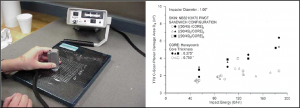
Figure 2: Example Material Subjected to Impact (Left) and Damage Area vs. Impact Energy (Right) [3].
A more recent DoT/FAA study by Neidigk et al. (2017) examined hail damage in 8- and 16-ply panels that were quasi-isotropic, symmetric [0,45,90,-45,0], and made with a T800 unidirectional prepreg tape with a 3900 series resin system made by Cytec. They did not develop equations but did produce damage area vs. impact energy plots for their material systems for 1.5-, 2.0-, and 2.4-inch-diameter simulated hail, as shown in Figure 3(a–c). In Figure 3(a-c), the through-transmission ultrasonic (TTU) method was used to determine only the area of delamination; this is why the damage area determined by the TTU method is always smaller than the damage area determined by the Mobile Automated Scanner (MAUS) pulse-echo ultrasonic (PE-UT) and OmniScan PE-UT methods [4].
Other damage area vs. impact energy experiments were also conducted in this work, including the following [4]:
- Spherical tip stringer flange impacts.
- Spherical tip mid-bay skin impacts.
- Substructure and skin delamination at shear tie impact sites.
- Substructure and skin delamination at mid-stringer impact sites.
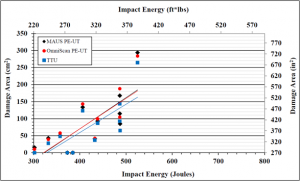
(a) Impact Damage Area of 38.1-mm Hail for 16-Ply CFRP Laminates [4].
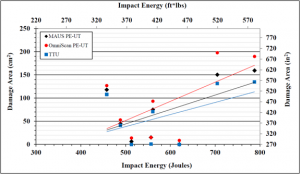
(b) Impact Damage Area of 50.8-mm Hail for 16-Ply CFRP Laminates [4].
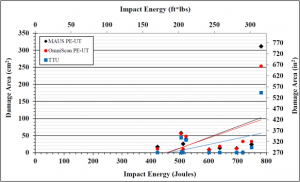
(c) Impact Damage Area of 61-mm Hail for 16-Ply CFRP Laminates [4].
Figure 3(a–c): Impact Damage Area of 38.1-, 50.8-, and 61-mm Hail for 16-Ply CFRP Laminates [4].
2.2 Non-government Work
The 2006 report, “Impact Damage Modelling of Composite Aerospace Structures Subject to Bird-Strike,” by Bayandor et al. discussed the generation of a model to predict impact damage to composite aero-structures subjected to bird strikes but did not provide any specific relations to estimate damage area [5].
In the article “Damage to Carbon/Epoxy Composite Plates Subjected to Mechanical Impact and Simulated Lightning,” Feraboli et al. examined effects to CRFP composites subjected to either impact or lightning damage, but only presented plots relating damage area to energy (0–~30 ft-lbs or 0–41 J for impact energy) for panels composed of Torayca T700S/2510 CFEP with a 1-inch steel indentor. All of the data in the work were experimental and no explicit equations were derived [6].
In the article “Impact Damage Prediction in Carbon Fiber-Reinforced Laminated Composite Using the Matrix-Reinforced Mixing Theory,” Perez et al. discussed the creation of an impact damage prediction method using matrix-reinforced mixing theory with finite element analysis. The researchers developed a plot of numerical and experimental results using a 16-mm diameter impactor for a quasi-isotropic composite with a stacking sequence of [45°/0°/-45°/90°]5S and at energies from 6.6 to 70 J (Figure 4) [7].
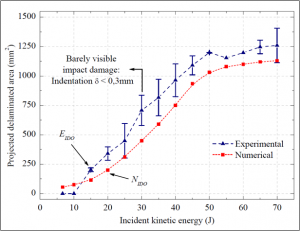
Figure 4: Projected Delaminated Area vs. Kinetic Impactor Energy for the Materials System and Impact Scenario [7].
2.3 Recent Work
The 2017 document, “The Effect of the Impactor Diameter and Temperature on Low Velocity Impact Behavior of CFRP Laminates,” offers some potential paths forward in impact damage prediction. It contains interesting research noting the difference in the damage area due to differences in the temperature of the composite. The results from these tests conducted using a 20-mm diameter impactor with CFRP (Hexcel) showed substantial increases in the damaged area (over an impact energy range from 10 to 100 J) as the temperature decreased (Figure 5) [8].
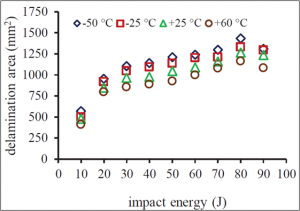
Figure 5: Delaminated Area vs. Kinetic Impactor Energy for the Materials System and Impact Scenarios (Investigating Different Impact Temperatures) [8].
The 2017 study, “Low Velocity Impact Response and Energy Absorption Behavior on Glass Fibre Reinforced Epoxy Composites,” by Shen et al. produced a number of plots relating impact energy (at lower BVID levels from 3 to 12 J) to delamination area for glass fiber-reinforced epoxy laminates with different ply thicknesses and reinforcement areas [9].
2.4 Works Providing Damage Prediction Equations
Two works were identified that provide equations to predict damage (delamination) diameter. Unfortunately, these equations do not use the impact energy, but rather use the impact force.
First, in the paper “Impact Damage Prediction in Carbon Composite Structures,” [10] authors G. A. O. Davies and X. Zhang discuss experimentally validating the following equation for determining the delamination envelope in a CFRP composite:

(1)
where A is the delamination envelope, r is the delamination radius, t is the composite thickness, P is the impact force, and τ is the maximum allowable interlaminar shear stress. The authors noted that best results for this relation are observed for thin composites, as thicker ones absorb more energy elastically compared to small, stiff panel configurations. In addition, it is assumed that the delamination pattern is fairly circular, which holds true until back-face tension splitting occurs along the fibers. The authors also noted that this method appears to work best for carbon composites, but not for other materials.
Second, in the document “The Use of Impact Force as a Scale Parameter for the Impact Response of Composite Laminates,” authors W. C. Jackson and C. C. Poe determined a linear relation between the impact force and maximum delamination diameter [11]. They noted that because there is a linear relationship between the impact force and the maximum delamination diameter, a constant transverse shear force can be associated with the delamination front. For a circular isotropic plate, the shear force per unit length (V) is given by:

(2)
where F is the impact/contact force and r is a radial distance defined as being much greater than the contact radius (r >> rc). Assuming Hertzian contact, rc is calculated by:

(3)
where n is the material Hertzian contact stiffness. The transverse shear force V* is associated with the edge of the delamination and can be calculated from the slope of the impact force and delamination diameter plot via:

(4)
where d0 = 2r is the maximum delamination diameter. However, this equation still requires a number of experimental tests to produce the slope for the impact force–delamination plot.
3.0 Summary
A number of papers specifically address the impact energy of an impactor (ranging from low velocity/low energy to high velocity/high energy) and its effect on the damage area of a composite. However, these studies are all highly dependent on the specifics of the laminates in the material system (fibers, epoxy, stack-up, etc.), impactor characteristics, and the impact circumstances (different velocities, impactor densities, etc., produce different results). In addition, there does not appear to be a developed set of equations that can predict the level of damage (short of experiments or complicated finite element analyses) without resorting to complicated simulations. Two equations were identified that produce damage area estimates, but they require knowledge of the impact force, rather than the impact energy [10, 11].
References
[1] Roach, D., S. Neidigk, T. Rice, and R. Duvall. “Inspection Options for Detecting Various Types of Impact Damage in Composite Structures.” 5th European-American Workshop on Reliability of Nondestructive Evaluation, Berlin, Germany, http://2013.nde-reliability.de/portals/nde-reliability2013/BB/poster/p4.pdf, 2013.
[2] Fawcett, A. J., and G. D. Oaks. “Boeing Composite Airframe Damage Tolerance Service Experience.” Presented at Damage Tolerance & Maintenance Workshop, Chicago, IL, https://www.niar.wichita.edu/chicagoworkshop/Chicago%20Damage%20Tolerance%20Workshop%20-%20July%2019-21,%202006/Wednesday%20-%20Session%201%20Presentations/ Boeing%20Transport%20Experience%20with%20Composite%20Damage%20Tolerance%20&%20Maintenance%20-%20Fawcett%20&%20Oakes.pdf, 19 July 2006.
[3] Shyprykevich, P., J. Toblin, L. Ilcewicz, A. J. Vizzini, T. E. Lacy, and Y. Hwang. “Guidelines for Analysis, Testing, and Nondestructive Inspection of Impact-Damaged Composite Sandwich Structures.” DOT/FAA/AR-02/121, Final Report, Office of Aviation Research, Washington, D.C., http://www.tc.faa.gov/its/worldpac/techrpt/ar02-121.pdf, March 2003.
[4] Neidigk, S. O., D. P. Roach, R. T. Duvall, and T. M. Rice. “Detection and Characterization of Hail Impact Damage in Carbon Fiber Aircraft Structures.” DOT/FAA/TC-16/8, U.S. Department of Transportation, Federal Aviation Administration, Washington, D.C., http://www.tc.faa.gov/its/worldpac/techrpt/tc16-8.pdf, September 2017.
[5] Bayandor, J., A. Johnson, A. S. Thomson, and M. Joosten. “Impact Damage Modelling of Composite Aerospace Structures Subject to Bird-Strike.” 25th International Congress of the Aeronautical Sciences, Hamburg, Germany, http://www.icas.org/ICAS_ARCHIVE/ ICAS2006/ PAPERS/676.PDF, 3–8 September 2006.
[6] Feraboli, P., and H. Kawakami. “Damage of Carbon/Epoxy Composite Plates Subjected to Mechanical Impact and Simulated Lightning.” Journal of Aircraft, vol. 47, no. 3, pp. 999–1012, https://arc.aiaa.org/doi/abs/10.2514/1.46486?journalCode=ja, 2010.
[7] Perez, M. A., X. Martinez, S. Oller, L. Gil, F. Rastellini, and F. Flores. “Impact Damage Prediction in Carbon Fiber-Reinforced Laminated Composite Using the Matrix-Reinforced Mixing Theory.” In Composite Structures, vol. 104, pp. 239–248, 2013.
[8] Evci, C., and I. Uyandiran. “The Effect of the Impactor Diameter and Temperature on Low Velocity Impact Behavior of CFRP Laminates.” AIP Conference Proceedings 1809, no. 020014, https://aip.scitation.org/doi/pdf/10.1063/1.4975429, 2017.
[9] Shen, Y., B. Jiang, Y. Li, and X. Jiang. “Low Velocity Impact Response and Energy Absorption Behavior on Glass Fibre Reinforced Epoxy Composites.” Science China Technological Sciences, vol. 60, no. 9, pp. 1339–1346, https://link.springer.com/article/10.1007/s11431-016-9061-3, 2017.
[10] Davies, G. A. O., and X. Zhang. “Impact Damage Prediction in Carbon Composite Structures.” International Journal of Impact Engineering, vol. 16, no. 1, pp. 149–180, https://www.sciencedirect.com/science/article/pii/0734743X9400039Y, 1995.
[11] Jackson, W. C., and C. C. Poe. “The Use of Impact Force as a Scale Parameter for the Impact Response of Composite Laminates.” National Aeronautics and Space Administration Technical Memorandum 104189, http://citeseerx.ist.psu.edu/viewdoc/ download?doi=10.1.1.134.2605& rep=rep1&type=pdf, January 1992.


